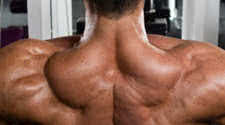Neck Muscles 101: Exercise & Strengthening for the Neck Muscles

Specific Muscle Building & Strengthen Features
The neck is the most neglected area of the body when it comes to exercise, and yet its one of the most important. Whether you're an ordinary person wanting to firm up a double chin or a football player wanting to avoid a Darryl Stingley experience - quadriplegia - the exercises in this article will help. Very little fancy equipment is required. Unfortunately, the few manufacturers that make neck machines have fallen short of the ideal neck-training apparatus for several reasons:
1. Leverage differences
The fixed leverage of the machine seldom matches the many different human neck lengths. Also, the machines remove the essential synergy factors required for control of the head, or the ability to maneuver through various planes of action. You're better off using ankle weights secured to your head with Velcro straps. The load of one to two pounds is quite sufficient even for the strongest trainee, and head weight is all you require initially.2. Uncomfortable
The padding on the aforementioned machines is such that few people can tolerate using them. Many said that it felt as though "my face was being torn off."3. Communicable diseases
It's possible to get pinkeye and other contagious afflictions from the exercise surfaces of these neck machines.4. Perspiration
Another reason that neck machines aren't very popular is because of the various microbes, such as staphylococcus, that are associated with sweat. This is also the reason why many trainees avoid leg curl machines and instead opt for stair machines, treadmills and rowing machines, on which the sweat drops to the floor.5. Weight requirement
Weight stacks aren't required, as head weight or one-to-two-pound ankle weights are sufficient for most trainees. The average head weight is 7 to 10 percent of bodyweight, so this generally amounts to 10 to 15 pounds.Psychosomatic Factors
The fear of developing a 20-inch neck, which would be highly valuable to a linebacker but appalling to 100-pound Mildred Smith, is just one reason so many people don't work on developing their necks. A strong neck is an advantage in all sports, however, from football and wrestling on the way to golf, tennis and baseball. Even maintaining a steady head, which is especially important in the latter three sports, requires not only practice but also neck strength and development. This is called a tonic training program, and it's based on developing chin lock. Chin lock requires a static contractile mode, or non movement ability of head control with respect to the vistibuiarmechanism located within each person's ears. This is the basis of balance.Do It Properly
There are four neck functions that you should train, with three- plus variations. The four movements are as follows:» Lie supine, or face up, while bending your head and neck forward.
» Lie prone, or facedown, while bending your head and neck backward.
» Lie on your right side, while bending your head and neck to the left.
» Lie on your left side while bending your head and neck to the right.
I suggest you include variations based on rotation and side bending as you progress. Combinations include forward bend and rotation concurrent action, forward- bend and side-bend concurrent action and side-bend and rotation concurrent action. This article only covers the four basic movements described above, however. Remember to keep your chin in while performing all these exercises.
Here's how to achieve chin lock:
When you raise your chin up and down, the action occurs at the atlanto-occipital joint at the neck, or the first vertebra. You should avoid this action and perform all exercise with your chin held in static contraction-the chin held against the Adam's apple or hyoid bone. This maneuver is quite difficult to perform, especially when you're doing the forward and backward bending in exercises 1 and 2 above.You must do the four variations as described because performing them either sitting or standing only works one-half of the range of motion due to the gravitational alignment factor. Doing the exercises in the various lying positions creates a full range of motion because there is no gravity-neutral effect.
Neck Exercises
Start with three reps and a four up / four-hold four-down cadence. Count out loud as you perform each rep. Cervical-head forward bending. Lie face up on a bench with your head hanging off the end, begin by observing the following points: » Align your jaw, or mandible by placing your teeth together. Your upper teeth should be even with your lower teeth. Check your bite by placing your finger against both upper and lower rows of teeth to insure 1-to-I alignment and maintain this static contraction throughout all neck exercises. This is quite difficult, and many trainees compensate, or cheat. The lack of this static contractile-stabilization control is evident by the tremor, or shaking, of the head-and-neck ensemble.» Pull your chin inward toward your Adam's apple in the chin-lock position.
» Your chin should not lift up as you do the exercise. Remember, this is quite difficult to do, and, if you're a personal trainer, your clients will need continual reminders. If it's too difficult to do this exercise flat, use the incline position
Side Bending
While lying on your side and with your head hanging over the end of the bench, reach down and grasp the leg of the bench for support. Align your teeth and tuck in your chin while maintaining your head in the center position. Move the upper ear to the shoulder on the same side. Count to eight as you return to the starting position.Cervical-head backward bending
Lie facedown, or prone, on a bench with your head hanging over the end and repeat points 1, 2 and 3 as described for cervical-head forward bending, only lift your head backward.» Align your jaw.
» Pull your chin in toward your Adam's apple.
» Do not allow your chin to rise up as you lift up your head. Use a four/four/four cadence.